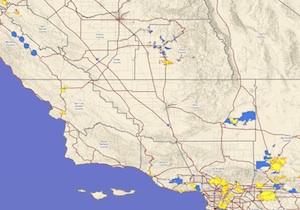
Blue indicates likely communities redlined by Charter, although analysis is still in progress. Yellow is where Charter offers broadband. Click for a bigger – 8.5 MB – version.
Hoping to get its proposed purchase of Time Warner and Bright House cable systems approved, Charter Communications filed a formal application with the California Public Utilities Commission earlier this month. Technically, it’s a joint filing of all three companies, but in reading through the claims and arguments, it’s clear that it’s primarily a Charter document.
Those claims include a statement that makes it sound like Charter is delivering broadband to all but a few of the Californians it serves…
Charter’s broadband Internet services deliver an industry-leading minimum of 60+ Mbps to the vast majority of its 4.8 million residential broadband customers, including to virtually all of its current customers in California.
Tellingly, the filing doesn’t repeat the assertion made in Charter’s parallel application to the Federal Communications Commission that its systems are “99% digital”, because clearly that’s not the case in California. The CPUC filing helpfully includes a list of places where Charter is “dedicated to providing quality products and services”, a list that disingenuously omits any mention of Monterey County or the six low income cities and unincorporated communities in the Salinas Valley that it has failed to upgrade to digital broadband technology. Just those redlined communities alone are home to more than 70,000 people; include surrounding unincorporated areas and people who don’t show up in census counts, and the total pushes 100,000.
And they’re not alone. An analysis by the Central Coast Broadband Consortium compared the broadband service reports Charter provides to the CPUC with the areas it’s been granted under a statewide franchise and found that there are significant areas of southern California and the central valley that are similarly redlined.
There’s more: that analysis didn’t pick up the northeastern California town of Alturas – I’m guessing because it was still operating under a local franchise when the data was published – which is another Charter-served area without cable modem service. And one that Charter also left off its list.
By qualifying its claim with virtually Charter might have avoided telling the CPUC an actionable lie. But painting a false picture with carefully omitted facts and well worn weasel words is equally deceptive. The CPUC should hold Charter equally accountable.
Joint application to the California Public Utilities Commission, 2 July 2015
Exhibit A – corporate certificates
Exhibit B – corporate certificates
Exhibit C – corporate certificates
Exhibit D – SEC filings
Exhibit E – SEC filings
Exhibit F – financials (completely redacted)
Exhibit G – merger agreement
Exhibit H – transaction structure
Edit 14 July 2014 – clarified population figures.
